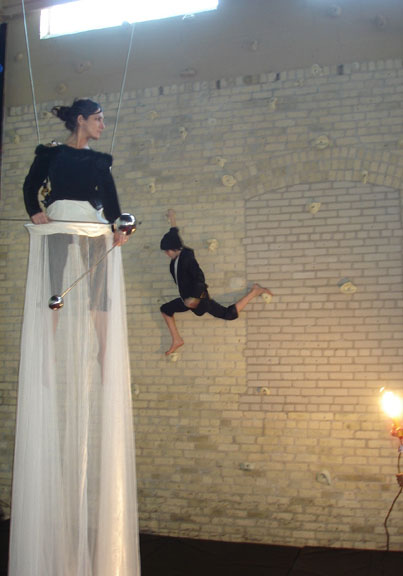Modern World: Metropolis and Its Readings
Lightsey Darst saw Between the Head and the Hands: a Transformation of Metropolis,a performance by Electropolis, Anne Elias, and the Xelias Aerialists at the Southern Theater. It was a lot: maybe too much?

“Between the Head and the Hands” is the latest evolution of the modern jazz group Electropolis’s live soundtrack for Fritz Lang’s 1927 futuristic parable Metropolis. This latest version, though, is not only a soundtrack, as now the Xelias aerialists are in the mix, shinnying up ropes, rolling on the floor, spinning on straps looped around the backs of their necks, and so on.
I say “and so on” because the Xelias contribution (choreographed by Anne Elias, Leah Nelson, and Meg Elias) feels loose and episodic. Dancers come on, set something up, do something, and exit, carrying their gear; this pattern repeats over and over, with irregular empty stretches interspersed.
What the dancers do is often impressive—take that neck spin, or Tamir Bayarsaihan’s astonishing hands-only climb up the Chinese pole—and occasionally mystifying—inflating plastic bags over a fan, tying off the puffed-up plastic bags, then untying, flattening, and folding the plastic bags, all in about 6 minutes. But what the dancers do is, ultimately, always distracting, because meanwhile Metropolis is playing on a scrim across the Southern’s great arch.
Metropolis doesn’t need visual accompaniment; it is enough, along with the fierce Electropolis score, for an evening. The stunning scenes of the giant machine, the new city, the collapse of the workers’ city, of the Machine-Man—all this occupies the eye enough. Metropolis also (like many silent films) is arguably a dance film: the workers lurch back and forth to a numbing beat, the main characters gesticulate with their entire bodies, and then there’s Brigitte Helm’s hideous but sexy robot slut, with her torqued shoulders, her electric spine, and her daggering hands. With all this onscreen, the dancers can’t help but be secondary.
Simple movements associated with the music came off best: for example, the singer Diana Grasselli contorting her body in grief as her voice rises in beautiful moaning.
Another moment in the production, though, suggests another possibility. As spoken-word artist Desdamona delivers a lyric speech inspired by the film, a black and white image of branches (not from the film, or at least not recognizably so) skews across a triangular section of the scrim. Here, the film does not predominate because it’s not playing. This is the only interruption of the film, which otherwise is played in its entirety, from start to finish.
“Between the Head and the Hands” is subtitled “A Transformation of Metropolis,” but as it is, the show is presentation, not transformation. If the film really were transformed—cut up, turned off at times, recreated—co-directors Anne Elias and Michael Ferrier would find the space to make the dance integral.